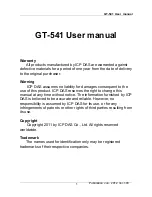
QuadroM 32x/8L/26x/12Li/26xi Manual II: Administrator's Guide
Administrator’s Menus
QuadroM 32x/8L/26x/12Li/26xi; (SW Version 5.2.x)
22
License Status
The
License Status
page displays a table with all available licenses on
the Quadro and the corresponding settings for each license. (Currently
only QCM license status is displayed.)
This page includes the following information:
Type
indicates the type of the license available on the Quadro.
Count
indicates the number of the corresponding licenses available on
the Quadro.
In Use
indicates the number of used licensed from the total available
licenses.
Extension
lists the extensions that are using the corresponding license.
Links in this column move to the corresponding service configuration
page for the extension.
Fig. II-34: License Status page
IP Routing Configuration
Routing
is used to relay information across the Internet from a source to a destination. Along the way, at least one intermediate node is typically
encountered. Routing is different than bridging. The main difference between bridging and routing is that bridging operates at the OSI Data Link
Layer (Level Two Media Access Control Layer) and routing operates at OSI Network Layer (Level Three).
Quadro’s
IP Routing
service allows you to route IP packets from one destination to another (or to a specified router) through Quadro or a Quadro
VPN.
The
IP Routing Configuration
page is used to make IP Static, IP Policy and VPN routes for IP packets routing. This page consists of three tables.
Entries in the tables are color coded according to the state of the route. For example, yellow indicates disabled routes, green indicates successful
routes and red indicates routes with an error.
IP Static Routes
are used to forward IP packets from the
Network, where the Quadro is connected, to the specified
destination.
The
IP Static Routes
table displays all established IP static
routes with their parameters:
Target State
for the state of the
route (enabled or disabled),
Actual State
for the state of the route
connection (up, down or erroneous),
Route To
for the subnet
where the incoming packets should be routed to and
Via IP
Address
for the router IP address where incoming packets should
be routed through.
Add
opens the
Add IP Static Route
page where a new static
route can be established.
Enable/Disable
is used to activate and deactivate a selected
route(s). At least one route should be selected in order to use
these functions, otherwise the following error message will
appear: “No record(s) selected.”
Fig. II-35: IP Static Routing table
The
Add IP Static Route
page offers the following components:
Route To
requires the IP address and subnet mask for the
destination the IP packet should be forwarded to.
Via IP Address
requires the IP address of the subsequent router
for IP packet forwarding to the specified destination.
Attention:
The rule with the longest subnet (smallest IP range)
will take effect when having two or more IP Static routing rules
with the coinciding subnets.
Fig. II-36: Add IP Static Routing page















































